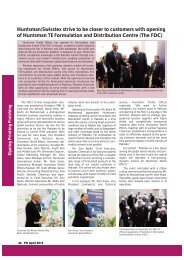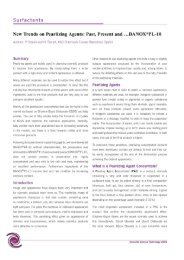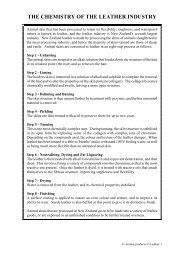Create successful ePaper yourself
Turn your PDF publications into a flip-book with our unique Google optimized e-Paper software.
PEOPLEWATCHING<br />
other person who is approaching us. Everyone knows the situation<br />
where two people are about <strong>to</strong> pass each other in a narrow<br />
space. One moves <strong>to</strong> his left and the other moves <strong>to</strong> his right, so<br />
that they are forced <strong>to</strong> halt, face <strong>to</strong> face. Sensing the mistake<br />
simultaneously, they both quickly adjust and step the other way,<br />
only <strong>to</strong> come face <strong>to</strong> face a second time. At this point they usually<br />
apologize and one pauses deliberately <strong>to</strong> let the other pass. Sometimes<br />
they both pause deliberately and each waits for the other <strong>to</strong><br />
pass. Now they have reached a stage where the simple passing<br />
action has become a verbal encounter, with each saying 'you<br />
first', 'no, you first'. This happens <strong>to</strong> everyone sooner or later in<br />
a corridor, a doorway or a street, but that it happens so rarely is<br />
a reflection of how well we read the Intention Movements of<br />
other people most of the time.<br />
Some Intention Movements are subtle, others crude. <strong>The</strong><br />
patient listener cornered by a bore may do no more than but<strong>to</strong>n a<br />
jacket, or uncross his legs. Or, in a standing encounter, he may<br />
start <strong>to</strong> edge away by backing slightly, or turning the body, while<br />
still keeping his face <strong>to</strong>wards the speaker. <strong>The</strong> first clues may be<br />
missed, but the last are inescapable. Even the most self-engrossed<br />
bore cannot misread the intentions of a companion who,<br />
although still smiling and nodding, is beginning <strong>to</strong> retreat.<br />
Because bores are often tragically aware that they are bores, they<br />
often resort <strong>to</strong> anti-Intention Movement devices. <strong>The</strong>y take the<br />
victim by the arm while talking <strong>to</strong> him, or place a hand on his arm<br />
or shoulder, so that it is more difficult for him <strong>to</strong> edge away. When<br />
we speak of 'but<strong>to</strong>nholing' someone, we visualize cornering them<br />
so that they cannot escape our attentions, but the word was<br />
originally 'but<strong>to</strong>nholding', and referred <strong>to</strong> a practice, common in<br />
previous centuries, of actually taking hold of a person's but<strong>to</strong>n<br />
while engaging them in conversation. Although this could not<br />
prevent the more subtle Intention Movements of escape it<br />
successfully blocked the cruder one of deliberately edging away.<br />
Only desperate measures could overcome this device, and there is<br />
an amusing observation, dating from 1808, that 'Charles Lamb,<br />
being but<strong>to</strong>n-held one day by Coleridge ... cut off the but<strong>to</strong>n.'<br />
At the opposite end of the scale from Intention Movements of<br />
fleeing are those threatening actions we see when someone<br />
260<br />
INTENTION MOVEMENTS<br />
becomes angry. <strong>The</strong> more subtle Intention Movements of attacking<br />
are the clenching of the fists, or the whitening of the knuckles<br />
as the hand grips tightly <strong>to</strong> some inanimate object. Cruder versions<br />
include the open-mouthed snarl and the raised arm. <strong>The</strong><br />
snarl is intriguing, because it appears <strong>to</strong> be the Intention Movement<br />
of biting, which was presumably one of our ancient methods<br />
of dealing with an opponent. Children, when very young,<br />
still resort <strong>to</strong> biting as an aggressive action, and nursery schools<br />
usually keep an eye open for the occasional, serious biter, but<br />
adults are more likely <strong>to</strong> use hands than teeth when indulging in<br />
free-for-all grappling. With them, only the primeval Intention<br />
Movement of the snarl remains, with the jaw open wide, the lips<br />
pulled back and the teeth exposed. <strong>The</strong>re is perhaps a slight sex<br />
difference here. Women have much weaker wrists and hands<br />
than men and, with them, the snarl may still sometimes extend<br />
beyond the Intention Movement stage and developed in<strong>to</strong> a fullblooded<br />
bite. In a recent court case, a woman was accused of<br />
biting off her neighbour's ear, when an argument got (literally)<br />
out of hand.<br />
<strong>The</strong> raised arm, with clenched fist, is the Intention Movement<br />
of the typical human overarm blow. In its less extreme form it<br />
consists simply of a slight upward movement of the forearm, but<br />
from this it can develop, either in<strong>to</strong> the characteristic fist-shake<br />
or the fully raised arm. <strong>The</strong> latter has become formalized as the<br />
Communist salute, where it symbolizes the aggression involved<br />
in the act of rebellion that initiated the Communist movement.<br />
Here the Intention Movement has become a fixed emblem and<br />
the gesture is an end in itself. It is no longer likely <strong>to</strong> develop in<strong>to</strong><br />
an actual blow at the moment of its performance, but indicates<br />
instead a generalized intention that expressed itself fully in the<br />
his<strong>to</strong>rical past and could do so again in the future.<br />
In one type of sport, boxing, the most important form of<br />
Intention Movement is not the true starting movement, but the<br />
false one - the feint. <strong>The</strong> boxer, fully aware that his opponent is<br />
alerted <strong>to</strong> every tiny jerk of his fists or tilt of his trunk and is<br />
reading these for the subtlest signs of any Intention Movement<br />
of attack, employs false Intention Movements as a repeated<br />
decoy system. It is possible <strong>to</strong> score any boxing match on a<br />
261


![Desmond Morris - 2002 - Peoplewatching - The Desmond Morris Guide to Body Language (poor quality-double page)(290p) [Inua]](https://img.yumpu.com/54998318/149/500x640/desmond-morris-2002-peoplewatching-the-desmond-morris-guide-to-body-language-poor-quality-double-page290p-inua.jpg)








![[Ulwick_A.W.]_Business_Strategy_Formulation_Theor(BookZZ.org)](https://img.yumpu.com/56355932/1/190x240/ulwick-aw-business-strategy-formulation-theorbookzzorg.jpg?quality=85)




